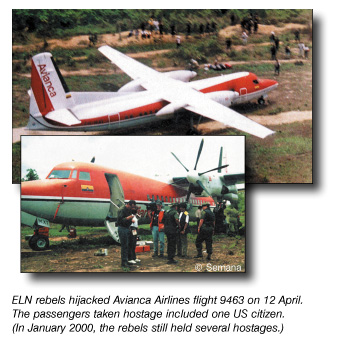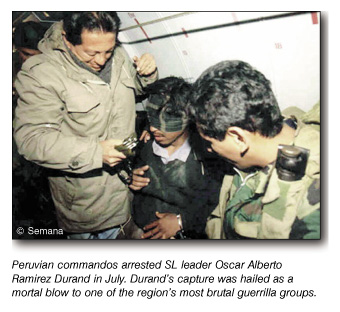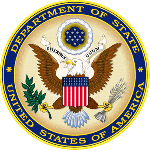
Although much of Latin America continued to be free from terrorist attacks,
Colombia, Peru, and the triborder region experienced terrorist activity. In
Colombia, insurgent and paramilitary terrorist groups continued to pose a significant
threat to the country's national security and to the security of innocent civilians
caught up in the conflict. Despite the beginnings of a slow and sometimes unsure
peace process, Colombia's two largest guerrilla groups, the Revolutionary Armed
Forces of Colombia (FARC) and the National Liberation Army (ELN), failed to
moderate their terrorist attacks. The ELN carried out several high-profile kidnappings,
including the hijacking in April of an aircraft carrying 46 persons and the
kidnapping in May of a church congregation that resulted in 160 hostages. The
FARC increased its attacks on Colombian security officials and attempted to
use kidnapped soldiers and police officers as bargaining chips in negotiations.
The FARC also kidnapped and killed three US nongovernmental organization workers
in March and outraged international public opinion by refusing to turn over
the perpetrators to the proper judicial authorities. The FARC continued refusing
to account for the three New Tribes Missionaries it kidnapped in 1993.
Over the year, US concern grew over the involvement of the FARC, the ELN, and
paramilitary groups in protecting narcotics trafficking. Estimates of the profits
to terrorist groups from their involvement in narcotics ranged into the hundreds
of millions of dollars. During 1999 the Colombian Army trained, equipped, and
fielded its first counternarcotics battalion, designed to support national police
efforts to break terrorist links to narcotics production.
In a development in the investigation of the bombing in 1992 of the Israeli
Embassy, the Supreme Court of Argentina released in May a report identifying
the cause as a car bomb and issued an international arrest warrant for Hizballah
terrorist leader Imad Mughniyah. Argentine authorities similarly brought charges
against all suspects being held in connection with the bombing of the Argentine-Israeli
Community Center (AMIA) in 1994.
Peru's determination to combat terrorism diminished the capabilities of both
the Sendero Luminoso (SL) and the Tupac Amaru Revolutionary Movement (MRTA).
Peruvian authorities arrested and prosecuted several of the few remaining active
SL members in 1999, including Principal Regional Committee leader Oscar Alberto
Ramirez Durand. Nonetheless, the SL continued to attack government targets in
the Peruvian countryside. A particularly deadly skirmish occurred in November,
leaving five soldiers and six guerrilla fighters dead. The MRTA has not conducted
a major terrorist operation since the end of the hostage crisis at the Japanese
Ambassador's residence in Lima in April 1997.
Argentina, Brazil, and Paraguay consolidated efforts to stem the illicit activities
of individuals linked to Islamist terrorist groups in the triborder region and
cooperated in promoting regional counterterrorist efforts. Argentina led efforts
to create the Inter-American Committee on Counterterrorism within the Organization
of American States (OAS).
Argentina
Investigations continued into the bombing of the Israeli Embassy in 1992
and the terrorist attack against the Argentine-Israeli Community Center (AMIA)
in 1994, both in Buenos Aires. In May the Argentine Supreme Court released a
report concluding that the attack on the Israeli Embassy was a car bomb and
issued an international arrest warrant for Hizballah terrorist leader Imad Mughniyah.
The investigating judge in the AMIA case determined in February that there was
insufficient evidence to continue holding an Iranian woman for possible complicity
in the bombing. In July, Argentine authorities brought charges against all suspects
then held in connection with the bombing, but at yearend the trials had yet
to begin.
The Argentine Government was one of the primary motivators in the creation
of the Inter-American Committee on Counterterrorism within the Organization
of American States.
Colombia
The nascent and slow-moving peace process did not prompt Colombia's two
largest guerrilla groups, the FARC and the ELN, or their paramilitary opponents
to reduce their terrorist activity. Bogota's exclusion of the ELN in talks it
began with the FARC was a factor in the ELN's series of spectacular hijackings
and kidnappings--including the Avianca hijacking in April that netted 41 hostages,
including one US citizen, and the Cali church kidnapping in May that took 160
hostages. With these acts the ELN sought to demonstrate its continued viability
and induce President Andres Pastrana to include it in the peace process as an
equal. For its part, the FARC escalated insurgent violence targeting security
officials to demonstrate its power and strengthen its negotiating position.

Colombian insurgent groups and paramilitaries continued to fund their activities
by protecting narcotics traffickers. Estimates of the profits to terrorist groups
from their involvement in narcotics ranged into the hundreds of millions of
dollars. In 1999 the Colombian Army trained, equipped, and fielded its first
counternarcotics battalion, designed to support national police efforts to break
terrorist links to narcotics production.
The FARC and ELN also generated income by kidnapping Colombians and foreigners
for ransom and extorting money from businesses and individuals in the Colombian
countryside. In addition, both insurgent groups attacked the nation's energy
infrastructure--including US commercial interests--by bombing oil pipelines
and destroying the electric power grid. US citizens who fell victim to guerrilla
terrorism, including three Indian rights workers the FARC kidnapped in Colombia
and murdered in Venezuela in March, were targeted because of wealth or opportunity
rather than their nationality. The whereabouts of the three New Tribes missionaries
kidnapped by the FARC in 1993 remain unknown.
In December, President Pastrana extended the FARC's demilitarized zone (DMZ)
through 7 June 2000. Reports of FARC abuses inside the DMZ continued to reduce
the FARC's popularity. Colombia's peace commissioner asserted that Bogota would
not enter official peace talks or a "National Convention" with the
ELN until all remaining hostages were released.
Peru
In 1999 the Peruvian judicial system continued to prosecute vigorously persons
accused of committing acts of international and domestic terrorism. Peruvian
authorities arrested and prosecuted several of the few remaining active SL members
in 1999, including Principal Regional Committee leader Oscar Alberto Ramirez
Durand (a.k.a. Feliciano). Feliciano had headed the decimated group since the
capture in 1992 of its founder and leader Abimael Guzman, and his arrest dealt
a mortal blow to one of the region's most violent rebel groups.

Peru's tough antiterrorist legislation and improved military intelligence diminished
the capabilities of both the SL and the MRTA. Both groups failed to launch a
significant terrorist operation in Lima in 1999 and generally limited their
activities to low-level attacks and propaganda in the rural areas. The SL continued
to attack government targets in the Peruvian countryside. Deadly clashes between
the SL and the military continued in the central and southern regions as soldiers
pursued two columns of approximately 60 to 80 rebels, led by "Comrade Alipio,"
through the southern jungle region. A particularly deadly skirmish occurred
in November, leaving five soldiers and six guerrilla fighters dead. The MRTA
has not conducted a major terrorist operation since the end of the hostage crisis
at the Japanese Ambassador's residence in Lima in April 1997.
The Government of Peru requested the extradition of SL member and suspected
terrorist Cecilia Nunez Chipana from Venezuela. The Government of Uruguay informed
Peru that MRTA member Luis Alberto Samaniego, whom Uruguay refused to extradite
in 1996, had disappeared.
Triborder Region: Argentina, Brazil, and Paraguay
In 1999 the Governments of Argentina, Brazil, and Paraguay consolidated
efforts to stem the illicit activities of individuals linked to Islamist terrorist
groups in the triborder region and continued to cooperate actively in promoting
regional counterterrorist efforts. Despite some success, however, the triborder
remained the focal point for Islamist extremism in Latin America.
[end of text]

Report Index
| 
